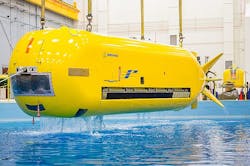DARPA Blue Wolf program adds Boeing and Lockheed Martin for military undersea vehicles research
Officials of the Naval Undersea Warfare Center (NUWC) in Keyport, Wash., have awarded the Boeing Co. and Lockheed Martin Corp. on behalf of the U.S. Defense Advanced Research Projects Agency (DARPA) in Arlington, Va., for the DARPA Blue Wolf program, which aims at sea testing of undersea energy, hydrodynamic lift, and drag-reduction technologies for manned and unmanned underwater vehicles (UUVs).
NUWC officials awarded a $2.5 million DARPA Blue Wolf contract to the Boeing Defense, Space & Security segment in Huntington Beach, Calif., on 11 Sept. 2015; and awarded a $2.5 million DARPA Blue Wolf contract to the Lockheed Martin Mission Systems and Training segment in Riviera Beach, Fla., on 17 Sept. 2015.
On the Blue Wolf program, Boeing and Lockheed Martin join the Charles Stark Draper Laboratory in Cambridge, Mass., which won a $3.7 million Blue Wolf contract in August, and Applied Physical Sciences (APS) Corp. in Groton, Conn., which won a $3.1 million Blue Wolf contract last July. Separately, Boeing won a $126,845 Blue Wolf contract last June.
Related: Military researchers gather contractors for fast, energy-efficient undersea vehicles
The Blue Wolf program will develop and demonstrate integrated underwater vehicle prototypes able to operate at speed and range combinations previously unachievable in fixed-size platforms, while retaining traditional volume and weight fractions for payloads and electronics, DARPA officials say.
Dynamic lift and drag reduction refers to revolutionary technologies for significant drag reduction, such as dynamic lift from winglets, body shaping, coatings, and novel drag reduction technologies applicable over various range and speed combinations to improve system energy efficiency.
Hybrid energy systems refers to approaches such as thermal, electrochemical, or energy-harvesting with two or more energy sources to improve energy efficiency measured in Watt hours per mile. DARPA researchers say they plan to explore thermal and electric sources like fuel cells and batteries that can fit within an undersea vehicle system module.
Undersea vehicle size, weight, and volume, traditionally are limited by handling, launch and recovery systems, DARPA officials explain. Mission performance typically sets the range, endurance, speed, and depth requirements, and the range of underwater vehicles is limited by the amount of energy available for propulsion and the power required for a given underwater speed.
This means that today's undersea vehicle size is proportional to the energy it needs for the missions the vehicle was designed for -- given the speed, range, and volume it needs for payloads and electronics.
Designers can modify the size of today's undersea vehicle designs by reducing hydrodynamic drag, improving lift-to-drag performance, or by improving the volumetric energy density of energy sources. There is a tradeoff, however. The volume and weight necessary to reduce drag or improve lift-to-drag in a fixed-size vehicle also reduces the volume and weight available for energy.
The Blue Wolf program seeks to break free of these limitations by focusing on energy, hydrodynamic lift, and drag-reduction technologies.
The initial reference architecture consists of a 21-inch-diameter vehicle with volume and weight reserved for baseline guidance, control, electronic systems, and payload section. The vehicle will use a baseline electric drive and conventional fin control.
In the first one-year phase of the program, the Blue Wolf contractors will design component and subsystem technologies for dynamic lift, drag reduction, and energy systems. An optional second phase will develop modules, and demonstrate safety, performance, and readiness for integration.
For more information contact Boeing Defense, Space & Security online at www.boeing.com/defense, Lockheed Martin Mission Systems and Training at www.lockheedmartin.com/us/mst, Draper Lab at www.draper.com, APS at www.aphysci.com, NUWC Keyport at www.navsea.navy.mil/Home/WarfareCenters/NUWCKeyport, or DARPA at www.darpa.mil.

